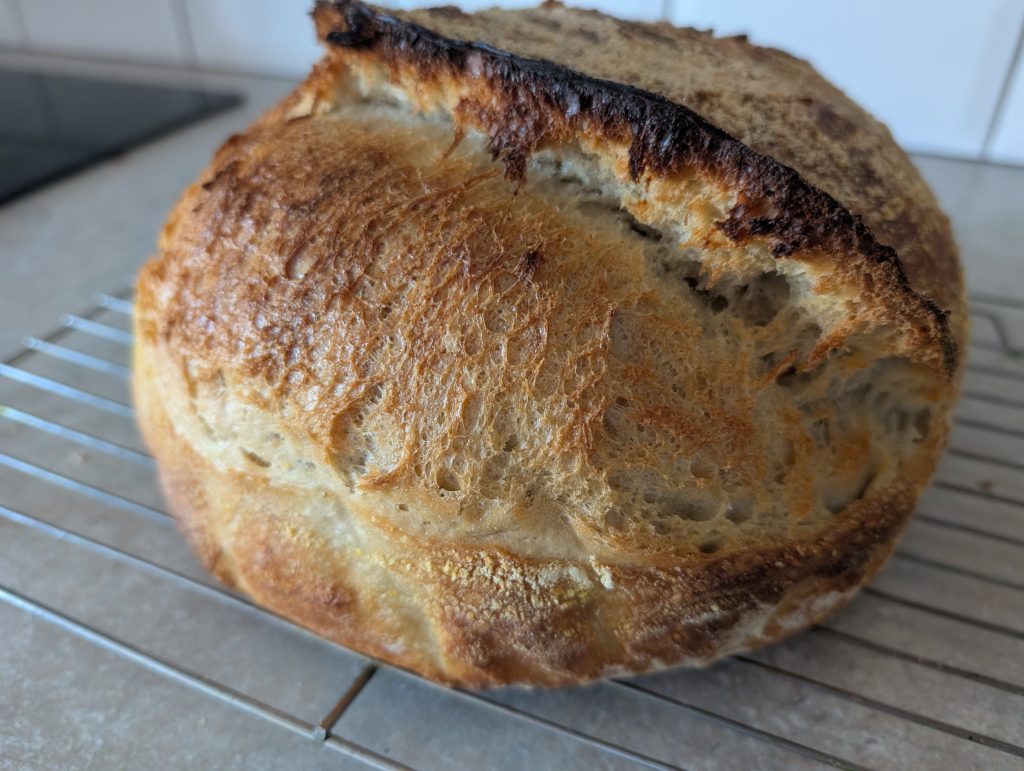is where the substance of your article begins to take shape.

🥖 How to Bake the Perfect Sourdough Bread — A Simple Guide for Beginners
There’s something magical about making sourdough bread. Watching simple ingredients like flour, water, salt, and a bit of starter transform into a golden, crusty loaf—it’s deeply satisfying. Whether you’re brand new or just want a foolproof method, here’s a simple, step-by-step guide to help you make your best sourdough yet.
🧪 What You’ll Need
- Flour (Bread flour or a mix with whole wheat)
- Water
- Sourdough starter (active and bubbly)
- Salt
- Optional: Proofing basket, Dutch oven, dough whisk, dough scraper, and seeds
Use our Sourdough Calculator to help you get the perfect ratios (just enter the amount of flour, and we’ll calculate the rest for you!).
Step 1: Mix It All Together
- In a large bowl, mix water and sourdough starter.
- In a separate bowl, combine flour and salt.
- Gradually add the flour mixture to the wet ingredients and stir until no dry bits remain. It doesn’t need to be kneaded—just mixed to incorporate.
- Tip: Use a dough whisk or your hand to bring everything together gently.
🛏️ Rest the dough for 20 minutes, covered with a damp cloth or lid. This step is called autolyse and helps start gluten development.
Step 2: Stretch and Strengthen
Now we build structure in the dough.
🥊 Slap & Fold
- Wet your hands lightly.
- Grab the dough in the middle and slap it gently down on the counter.
- Fold it over itself, then rotate and repeat 4–5 times.
- Shape it into a smooth ball by tucking it under itself.
- Rest for 30 minutes, covered.
🌀 Coil Folds
- Lift the dough gently and fold it under itself like a soft coil.
- Repeat 3–4 times around the dough.
- Cover and rest 30 minutes.
✅ Repeat the coil folds 1 or 2 more times with 30-minute rests in between.
Step 3: Bulk Fermentation
Transfer the dough into a lightly oiled bowl and cover it.
⏳ Let it rise at room temperature for 4–5 hours until puffed up and smooth. It should feel alive and elastic.
Step 4: Pre-Shape & Final Shape
Pre-Shape
- Turn the dough out onto a floured surface.
- Gently cross-fold and coil it into a loose ball.
- Let it rest for 30 minutes, uncovered.
Final Shape
- Give it two gentle coil folds and one more set of cross-folds.
- Tuck and roll the dough into a tight, smooth ball.
- Keep the seam side down.
✨ Optional: Press the dough into seeds on a plate (seam down), and sprinkle flour on top and sides.
Place into a well-floured proofing basket, seam down. Dust with more flour if needed.
Step 5: Cold Proof
Place the basket in the fridge, covered, for 8–24 hours. This slow cold proof develops amazing flavor and makes the dough easier to handle.
Step 6: Bake!
🔥 Preheat your oven with a Dutch oven inside to 240°C (465°F) for 30–40 minutes.
- Take the dough from the fridge.
- Gently flip it onto baking paper.
- Score it: make a 5mm deep slash across the top at a 45° angle—this controls how it expands.
- Place it into the hot Dutch oven.
- Add 2 tablespoons of water between the parchment paper and the Dutch oven wall, then quickly close the lid (for steam!).
🍞 Bake:
- 20 minutes with the lid on.
- 15–20 minutes more with the lid off at 230°C (445°F).
🕒 Let It Rest
Once baked, remove and let the bread cool for at least 20–30 minutes. This sets the crumb and makes slicing easier.
🥂 Enjoy!
You did it! You just baked your own sourdough bread. Crispy crust, soft interior, and the incredible smell of fresh bread in your kitchen—it’s unbeatable.
Want to try it now? Start with our Sourdough Calculator and mix your first batch today.











